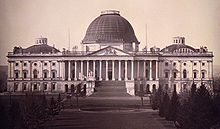
Back كونجرس امريكا ال33 ARZ 33. Kongress der Vereinigten Staaten German Kongres Amerika Serikat ke-33 ID
| 33rd United States Congress | |
|---|---|
32nd ← → 34th | |
 United States Capitol (1846) | |
March 4, 1853 – March 4, 1855 | |
| Members | 62 senators 234 representatives 7 non-voting delegates |
| Senate majority | Democratic |
| Senate President | William R. King (Democrat) (until April 18, 1853) Vacant (from April 18, 1853) |
| House majority | Democratic |
| House Speaker | Linn Boyd (Democrat) |
| Sessions | |
| Special[a]: March 4, 1853 – April 11, 1853 1st: December 5, 1853 – August 7, 1854 2nd: December 4, 1854 – March 4, 1855 | |
The 33rd United States Congress was a meeting of the legislative branch of the United States federal government, consisting of the United States Senate and the United States House of Representatives. It met in Washington, D.C. from March 4, 1853, to March 4, 1855, during the first two years of Franklin Pierce's presidency. During this session, the Kansas–Nebraska Act was passed, an act that soon led to the creation of the Republican Party. The apportionment of seats in the House of Representatives was based on the 1850 United States census. Both chambers had a Democratic majority.
Cite error: There are <ref group=lower-alpha> tags or {{efn}} templates on this page, but the references will not show without a {{reflist|group=lower-alpha}} template or {{notelist}} template (see the help page).